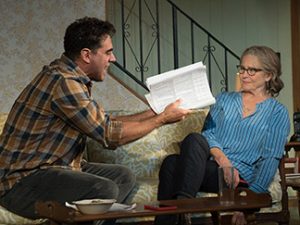By Lucy Komisar
This is a play about an important problem for journalism that begins with a trivial argument over whether the bricks in a building were red or brown. Or maybe what seems like minutae are the building blocks that lead to more serious inventions. As the play by Jeremy Kareken, David Murrell, and Gordon Farrell is based on a nonfiction work about a real fact-checker, Jim D‘Agata, I assume it followed its trajectory.

The cast of theater actors is fine, Bobby Cannavale as the arrogant, self-important writer, Daniel Radclifffe as the sincere and relentless fact-checker and Cherry Jones as the magazine editor distraught about a copy deadline. Director Leigh Silverman makes it all appear quite real, which indeed it was.
John, who lives in Las Vegas, has written a piece about a 16-year-old youth who jumped off an observation deck to his death. His problem is he feels obliged, probably by editors, to include a lot of local color. When he doesn‘t have it, he makes it up. This is not unusual. It started out as “the new journalism” in the 60s and 70s, later was retitled “faction” by some detractors, and now is quietly accepted, until writers are found out.
In this case, an editor asked Jim (Radcliffe) a fact-checker to check a 15-page article (which John insists is not an “article,” but an “essay,” which I assume he thinks has more class), and Jim writes a 130-page critique.
For example, he questions whether there are 31 or 34 strip clubs in Vegas. John admits he made up 34, because he liked the rhythm.

He has a line about finding the oldest bottle of Tabasco sauce and a woman beating a chicken in tic-tax-toe. John declares that facts are a herd of white horses. To corral?
Is this a satire? I wondered. Or criticism of the rampant fake news in current mainstream journalism.
Things on bi-coastal phone calls get so desperate, that editor Emily flies from New York to Las Vegas. When from time to time her phone rings, it plays “Ode to Joy.” How very chic.
We learn that in a background section about Las Vegas suicides, John wrote that a young woman hanged herself, but actually she jumped off a building. He changed the fact, because the truth might have made the boy‘s suicide less sui generis.
He talks about a traffic jam of five dozen cars and 100 people in an intersection, but Jim points out there would be three or four cars in each lane, and, “I don‘t call that a jam.”
There is applause, which I translated as the audience now getting tired of journalists making things up. Besides, we learn that that selling ads in the magazines depends on trust. More pedestrian, if the magazine doesn‘t run this story, the filler is about “congressional spouses and the burdens they share.” Ugh!

Some of this writing is hokey. “Do you want a drink?” gets Jim‘s response: “Do you have any craft ale, like an IPA?” John, of course, is drinking Scotch.
But the editor keeps insisting that John “can write.” And John insists that Cicero and Plutarch changed facts. And that he “started with the facts, but more.” He was “writing to Levi‘s spirit, not his body.” And “what is truth?”
He insists that precise numbers tell nothing. “I studied his drawing. I walked in his footsteps.” He writes that Levi sat on the ledge for 18 seconds.
Did someone there have a timer? And why didn‘t that person intervene? Now we know all the embellishments add up to a fake. So, what is real about this piece?
I have strong feelings about this, as my own experience with such fakery goes back to the early 1980s, when I was one of four journalists invited by Oxfam America to visit El Salvador. The war between the oligarchy and people seeking to topple them was heating up, but the four American churchwomen had not yet been murdered, and the US public was not aware of the conflict.
I would write the first article opposing US government support for the Salvador killer military: “For battered little El Salvador, US aid is no helping hand,” Los Angeles Times, Sept. 21, 1980.
Another writer on the trip was T.D. Allman. His article in “Harper‘s” stunned me: “Rising to Rebellion.” Harper’s, March 1981.
He wrote: It was my last full day in El Salvador, and I had traveled to Aguilares in hope of meeting some guerrillas and making contact with the revolutionary front.
We had abandoned the car in a blind of bamboo stalks, and were picking our way through a no man’s land of felled trees and drainpipes laid across the dirt road, of pungi sticks made of sharpened branches and planted, like some experimental crop, in shallow excavations.
After a few minutes I could sense we were not walking alone. The rustling of the trees became a rustling apart from the trees; then the rustling became a series of shadows and the shadows grew into silent forms that appeared on the trail in front of us, behind us, on both sides. The insurgent forces, as they are described in the official communiques, had a few flint locks among them, but their main weapons were machetes; and they seemed as thin as their own machetes.
Then he describes meeting with Salvador General Garcia: In his fortified office he showed me his new Betamax-used more for recording political interrogations than taping soccer games. Like the spare parts for the helicopters, jeeps, and armored cars, it derived from the United States’ nonlethal military assistance to the regime. It is indeed regrettable, Garcia agreed, that so many murders occur and so few are punished. But what can I do? The minister shrugged as he poured me some excellent Salvadoran coffee. I urge you to voice these same concerns to the commander of the Guardia Civil.
A few nights later, our acquaintance became more intimate. Colonel Garcia poured me some excellent French champagne at a reception at the presidential palace, while we discussed the junta’s efforts to redistribute El Salvador’s wealth through a Land to the Tiller campaign devised by an American veteran, of the pacification campaign in Vietnam. As the reception drew to an end, the military band played flourishes, and the gold- braided Salvadoran officer corps gathered in the lobby under a crystal chandelier to reclaim the revolvers they had checked at the door, Colonel Garcia grasped my hand and gave me his card….
Intrepid reporter, right? It was cinematic, exciting, led to his getting a book publication. Except it was fake journalism, because he never explains that this was a press trip! That he was one of four reporters led by an organizer of Oxfam, the international aid agency, who had set everything up. Every event, every meeting, every walk in the forest. Allman‘s “intimate” meeting with Garcia was a fake. I was there (the whole group was at the reception as we traveled everywhere together) and I translated, since Allman spoke no Spanish.
But the true story would not be glamorous enough for Harper‘s. So, he made a better story up. I wrote Harper‘s a letter, but they never answered or printed it. So, fakery sells. Which is the message of the play.
I see this now in the western press fakery about the William Browder/Sergei Magnitsky hoax, which dominates every story you see in mainstream and so-called alternative media. For the truth about the tax cheating conman who invented a story about his tax accountant being a lawyer murdered by the Russian, check out The Komisar Scoop. You won’t get the story in the MSM, which routinely repeats Browder’s lies.
This play raises an important question, but hardly scratches the surface about western media‘s fake news.
“The Lifespan of a Fact.” Written by Jeremy Kareken, David Murrell, Gordon Farrell. Directed by Leigh Silverman. Based on a book by Jim Fingal. About an essay by Jim D‘Agata. Studio 54, 254 West 54th Street, New York City. 212-239-6200 or 800-447-7400. Opened Oct 18, 2018, closes Jan 13, 2019. Runtime 1:35. 12/3/18.

